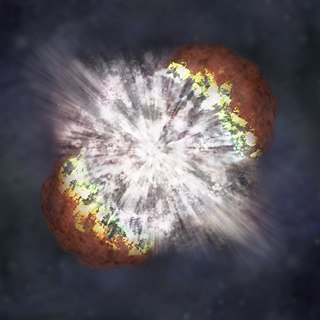
In gamma-ray astronomy, gamma-ray bursts (GRBs) are immensely energetic events occurring in distant galaxies which represent the brightest and "most powerful class of explosion in the universe." These extreme electromagnetic events are second only to the Big Bang as the most energetic and luminous phenomenon ever known. Gamma-ray bursts can last from a few milliseconds to several hours. After the initial flash of gamma rays, a longer-lived § afterglow is emitted, usually in the longer wavelengths of X-ray, ultraviolet, optical, infrared, microwave or radio frequencies.

A super-luminous supernova is a type of stellar explosion with a luminosity 10 or more times higher than that of standard supernovae. Like supernovae, SLSNe seem to be produced by several mechanisms, which is readily revealed by their light-curves and spectra. There are multiple models for what conditions may produce an SLSN, including core collapse in particularly massive stars, millisecond magnetars, interaction with circumstellar material, or pair-instability supernovae.
GRB 971214 is a gamma-ray burst observed in 1997. It originated 12 billion light years away. For a brief period this was thought by some researchers to have been the most energetic event observed in the universe, but this was before it was established that gamma-ray bursts are beamed towards the Earth. Thus, at the time of the discovery it was hypothesized by G. Djorgovski and his collaborators that the outburst put out more energy than several hundred typical supernovae, or the energy our galaxy puts out over a couple of centuries. However, a couple of years later it was realized that this was an upper limit as it is likely that the burst was directed towards Earth. If the jet had an opening angle of only a few degrees, the burst energy could have been thousands of times lower. The X-ray afterglow and the host galaxy of the GRB have also been observed, using BeppoSAX and Keck II respectively. The host galaxy lies at redshift z=3.4.
Dale A. Frail is a Canadian astronomer working at the National Radio Astronomy Observatory (NRAO) in Socorro, New Mexico.

SN 1998bw was a rare broad-lined Type Ic gamma ray burst supernova detected on 26 April 1998 in the ESO 184-G82 spiral galaxy, which some astronomers believe may be an example of a collapsar (hypernova). The hypernova has been linked to GRB 980425, which was detected on 25 April 1998, the first time a gamma-ray burst has been linked to a supernova. The hypernova is approximately 140 million light years away, very close for a gamma ray burst source.
Gamma-ray burst emission mechanisms are theories that explain how the energy from a gamma-ray burst progenitor is turned into radiation. These mechanisms are a major topic of research as of 2007. Neither the light curves nor the early-time spectra of GRBs show resemblance to the radiation emitted by any familiar physical process.

Gamma-ray burst progenitors are the types of celestial objects that can emit gamma-ray bursts (GRBs). GRBs show an extraordinary degree of diversity. They can last anywhere from a fraction of a second to many minutes. Bursts could have a single profile or oscillate wildly up and down in intensity, and their spectra are highly variable unlike other objects in space. The near complete lack of observational constraint led to a profusion of theories, including evaporating black holes, magnetic flares on white dwarfs, accretion of matter onto neutron stars, antimatter accretion, supernovae, hypernovae, and rapid extraction of rotational energy from supermassive black holes, among others.

GRB 970508 was a gamma-ray burst (GRB) detected on May 8, 1997, at 21:42 UTC; it is historically important as the second GRB with a detected afterglow at other wavelengths, the first to have a direct redshift measurement of the afterglow, and the first to be detected at radio wavelengths.
The history of gamma-ray began with the serendipitous detection of a gamma-ray burst (GRB) on July 2, 1967, by the U.S. Vela satellites. After these satellites detected fifteen other GRBs, Ray Klebesadel of the Los Alamos National Laboratory published the first paper on the subject, Observations of Gamma-Ray Bursts of Cosmic Origin. As more and more research was done on these mysterious events, hundreds of models were developed in an attempt to explain their origins.

GRB 051221A was a gamma ray burst (GRB) that was detected by NASA's Swift Gamma-Ray Burst Mission on December 21, 2005. The coordinates of the burst were α=21h 54m 50.7s, δ=16° 53′ 31.9″, and it lasted about 1.4 seconds. The same satellite discovered X-ray emission from the same object, and the GMOS Instrument on the Gemini Observatory discovered an afterglow in the visible spectrum. This was observed for the next ten days, allowing a redshift of Z = 0.5464 to be determined for the host galaxy.
GRB 980425 was a gamma-ray burst (GRB) that was detected on 25 April 1998 at 21:49 UTC. GRB 980425 occurred at approximately the same time as SN 1998bw, providing the first evidence that gamma-ray bursts and supernovae are related, and at a distance of 40 megaparsecs (130,000,000 ly), remains the closest GRB yet observed.
GRB 020813 was a gamma-ray burst (GRB) that was detected on 13 August 2002 at 02:44 UTC. A gamma-ray burst is a highly luminous flash associated with an explosion in a distant galaxy and producing gamma rays, the most energetic form of electromagnetic radiation, and often followed by a longer-lived "afterglow" emitted at longer wavelengths.
GRB 011211 was a gamma-ray burst (GRB) detected on December 11, 2001. A gamma-ray burst is a highly luminous flash associated with an explosion in a distant galaxy and producing gamma rays, the most energetic form of electromagnetic radiation, and often followed by a longer-lived "afterglow" emitted at longer wavelengths.
GRB 031203 was a gamma-ray burst (GRB) detected on December 3, 2003. A gamma-ray burst is a highly luminous flash associated with an explosion in a distant galaxy and producing gamma rays, the most energetic form of electromagnetic radiation, and often followed by a longer-lived "afterglow" emitted at longer wavelengths.
GRB 030329 was a gamma-ray burst (GRB) that was detected on 29 March 2003 at 11:37 UTC. A gamma-ray burst is a highly luminous flash associated with an explosion in a distant galaxy and producing gamma rays, the most energetic form of electromagnetic radiation, and often followed by a longer-lived "afterglow" emitted at longer wavelengths. GRB 030329 was the first burst whose afterglow definitively exhibited characteristics of a supernova, confirming the existence of a relationship between the two phenomena.
GRB 070714B was a gamma-ray burst (GRB) that was detected on 14 July 2007 at 04:59 UTC. A gamma-ray burst is a highly luminous flash associated with an explosion in a distant galaxy and producing gamma rays, the most energetic form of electromagnetic radiation, and often followed by a longer-lived "afterglow" emitted at longer wavelengths.

Tsvi Piran is an Israeli theoretical physicist and astrophysicist, best known for his work on Gamma-ray Bursts (GRBs) and on numerical relativity. The recipient of the 2019 EMET prize award in Physics and Space Research.

Daniel E. Reichart is an American astronomer. Reichart’s dissertation research on distant, cosmic explosions called gamma-ray bursts was ranked by Science Magazine as one of the top ten discoveries in science in 1999, and in 2003 earned him the Robert J. Trumpler Award, for top astrophysics dissertation research in North America. In 2005, he and his students discovered the most distant explosion in the universe yet known, a gamma-ray burst that occurred 12.9 billion years ago, when the universe was only 6% its current age.

A hypernova is a very energetic supernova which is believed to result from an extreme core collapse scenario. In this case, a massive star collapses to form a rotating black hole emitting twin astrophysical jets and surrounded by an accretion disk. It is a type of stellar explosion that ejects material with an unusually high kinetic energy, an order of magnitude higher than most supernovae, with a luminosity at least 10 times greater. Hypernovae release such intense gamma rays that they often appear similar to a type Ic supernova, but with unusually broad spectral lines indicating an extremely high expansion velocity. Hypernovae are one of the mechanisms for producing long gamma ray bursts (GRBs), which range from 2 seconds to over a minute in duration. They have also been referred to as superluminous supernovae, though that classification also includes other types of extremely luminous stellar explosions that have different origins.









